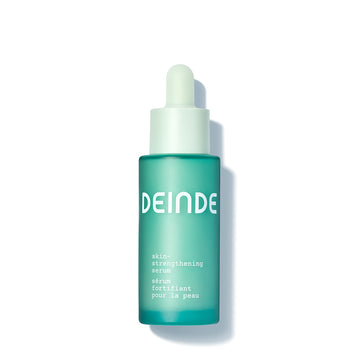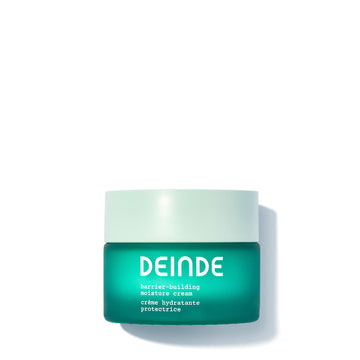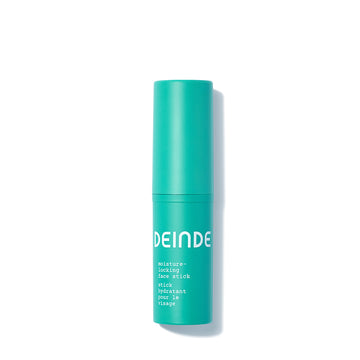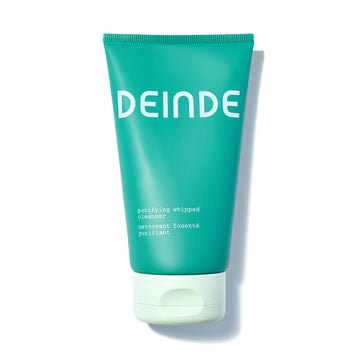
The 6 Best Skincare Ingredients for Mid-Late 20s
Life can be marked by different chapters. Our skin follows suit. Generally, we think about skincare transitions through the following buckets: youth, adulthood, and maturity. Understanding the critical shifts in skin functionality at a cellular level during a lifetime can dictate what habits make the most sense for your current state.
There is no anti-aging sentiment here, simply a biological investigation of what prompts the even textures, strong cellular structures, and resilience synonymous with healthy skin. DEINDE believes that the more we invest in creating an ideal skincare environment and understand how cells age, the better our quality of life can be.
In our eyes, taking care of our skin is an investment in the future. By taking small actions daily, like cleansing and hydrating the skin, skin becomes resilient and supported. This baseline state of skin goes a long way when we’re faced with external stressors, inflammaging, the natural aging process, and the highs and lows of life itself.
What skin changes occur in your 20s?
The 20s are a transformative time for a few reasons. In addition to the maturation of skin, it’s a decade to determine priorities and lifestyle choices, and establish your identity.
During your early 20s, skin remains bright and bouncy due to peak collagen and elastin production. Sebum production is generally balanced, and the skin barrier is strong, which provides natural and healthy hydration levels. The body is still operating at an increased metabolic rate. Cell turnover is exceptionally efficient, promoting the regeneration of new, healthy cells. Often, skin concerns from the teenage years, like acne, excess oil, and blackheads, diminish due to hormonal shifts, improved habits, and the natural maturation of skin. Long-term damage from UV is rarely present during this time.
In your mid-20s, skin begins to subtly change. There’s a slight decline in collagen and skin turnover — you may notice more dead skin cells, slight discoloration or dark spots, and a rise in patches of oily or dry skin. Your natural regenerative process simply doesn’t work as effectively as it once did — the skin now welcomes support from external products. This is the first time you’ll see the impact of your previous skin routines. It marks an important milestone to continue incorporating preventative skincare to protect skin from unnecessary damage in the future. During this period, it’s best to focus on targeted interventions.
At the end of your 20s, you may notice a hint of tiny fine lines. It’s generally still too early to see obvious signs of aging, like wrinkles, but during this time, you’ll start to understand the cause and effect of how you treat your skin. This is the time to ensure that you have a tried-and-true skincare routine that cleanses, exfoliates, tones, and moisturizes. This is also an opportunity to invest in scientifically proven skincare products that include supportive ingredients for the next chapters of your life.
Why are the best skincare ingredients for the defining decade?

The products you used at the tail end of your teenage years and early 20s just won’t cut it anymore. Your skin has reached a new chapter — the harsh cleansers and drying astringents from high school don’t match up with what your skin is craving. This is the time to invest in yourself through smart formulations that include targeted ingredients. At a high level, you’ll want to focus on:
-
Enhancing Skin Cell Renewal → Promoting sustained renewal accelerates the shedding of dull and damaged cells, creating space for fresh, radiant skin. A blank canvas not only revitalizes the skin’s surface but encourages the effective absorption of skincare products to maximize their benefits.
- Stimulating Collagen Production → As collagen naturally decreases with age, jumpstarting production through active ingredients like peptides and Vitamin C visibly reduces the look of wrinkles and sagging.
- Hydration and Moisture Retention → Optimal hydration levels are fundamental for healthy skin functionality as they strengthen the skin barrier and prevent moisture loss. Hydrated skin tends to be more resistant to external stressors, reducing unnecessary irritation, redness, or inflammation.
- UV Protection → In your 20s, SPF should be a priority. Regularly using sunscreen shields the skin from harmful UVA and UVB rays, preventing the loss of skin elasticity and sun-driven impacts that will emerge down the line. This is a simple investment with long-term benefits.
During this time, reaching for specific active ingredients is essential to develop the foundation for long-term skin health. This pivotal decade marks a phase where the skin is still relatively resilient. This is an opportune time to proactively address potential concerns before they escalate. A preventative skincare routine can yield lasting benefits for years to come. Some during this time include:
→ NARINGENIN
A DEINDE favorite, Naringenin is a flavonoid commonly found in citrus fruits. It’s recognized for its powerful antioxidant properties that help support the skin during exposure to environmental stressors, free radicals, and oxidative damage. Naringenin is best known for its soothing properties — see DEINDE’s Naringenin for a deep dive into the science behind this. Gentle, yet effective, Naringenin is a scientifically supported essential for maintaining optimal skin health and combatting early inflammaging.
→ HYALURONIC ACID
In your 20s, skin is still resilient but requires proactive care. Hyaluronic acid helps replenish and lock in moisture, preventing dehydration and dryness by attracting water molecules without clogging pores or causing irritation. Hyaluronic acid is also recognized for supporting the skin’s natural barrier function.
→ PEPTIDES
Peptides are short chains of amino acids that are key to collagen synthesis. As collagen production declines in your 20s, incorporating peptides helps maintain the skin’s structural integrity, reducing the look of early signs of aging like fine lines and wrinkles. More importantly, peptides support the skin’s natural repair processes.
→ NIACINAMIDE
Recognized for its soothing properties, niacinamide helps maintain balanced oil production and combats moisture loss. Also known as Vitamin B2, Niacinamide is a water-soluble vitamin known to reduce redness and uneven skin tone while maintaining healthy oil production.
→ VITAMIN C
Incorporating a vitamin C serum adds a powerhouse layer of sun protection and supports skin during exposure to oxidative stress that can accelerate premature aging. Vitamin C’s skin-brightening properties can reduce the look of hyperpigmentation and even the appearance of your skin tone, while laying the groundwork for a protected complexion.
→ SUNSCREEN
This chapter is all about prevention and protection for glowing skin. Sunscreen is non-negotiable for all skin types, as UV rays are a major contributor to the development of fine lines, wrinkles, and sunspots. Beyond visual aging indicators, sunscreen protects the skin from skin cancer risk.
What should you know about collagen and elastin?
Your 20s are often referred to as the “defining decade.” That same sentiment applies to your skin, especially when considering collagen and elastin. A youthful skin structure is supported by a thick epidermal due to a consistent blood flow that carries ideal levels of oxygen and nutrients. While we can’t reverse the clock, we do believe it’s important to highlight that optimal collagen and elastin levels do more than just make skin look visually younger — they act as an indicator of a biologically healthy body.
Collagen, the most abundant protein in the skin, forms a structural framework. This framework, synthesized by fibroblast cells, is key to strong and supported skin. Collagen fibers create a complex network that helps prevent sagging and wrinkling, lending to a smooth and supple appearance. Think of collagen as the foundation for skin’s structure — how these fibers are organized determines skin texture and its ability to bounce back after stress.
Research shows that “from early adulthood, fibroblasts become less active, and collagen declines by about 1.0% - 1.5% a year.” There’s a consensus among the scientific community, backed by several studies, that collagen production peaks in your mid-20s. External factors, like UV exposure or inflammaging, can impede collagen production and accelerate a gradual breakdown of this framework.
Elastin, another essential protein, complements collagen by encouraging elasticity in the skin. Elastin fibers allow for skin to stretch and move without lasting damage. Where collagen provides structure and order, elastin provides mobility and shape. Elastin does not have a well-defined peak like collagen, rather has a more stable rate of production well past your 20s. As we age, elastin fibers can degrade if overexposed to harsh environmental factors
What does cellular renewal look like in your 20s?
Cellular turnover, sometimes referred to as cell renewal or regeneration, refers to the constant replacement cycle of old, damaged skin cells with new, healthy ones. Skin cells are formed via the following process:
-
Cell Division → Basal cells are consistently dividing and producing new cells at the deepest layer of the epidermis.
-
Stem Cells → This type of cell can develop into specialized cell types — examples include keratinocytes (the primary skin cell), melanocytes (cells that produce pigment), and Merkel cells (cells that prompt touch sensation).
-
Keratinocyte Differentiation → Once cells are divided and developed, they migrate upward through epidermal layers. During this transition, cells go through differentiation, a process that changes cell shape, structure, and function to fulfill skin barrier function needs.
- Melanin Production → Melanocytes produce melanin, the pigment that determines skin color and protects from harmful UV rays.
- Migration and Maturation → Once cells are divided and developed, they migrate upward through epidermal layers. As cell adhesion changes, cells reach the stratum corneum and become flattened, lose their nucleus, and create a protective barrier.
- Desquamation → Dead and damaged cells at the surface are continuously shed through natural exfoliation. The removal of old cells allows for the next iteration of healthy cells.
If and when cellular turnover is reduced, you’ll notice a duller complexion. Generally, skin renews itself during your 20s between 24-30 days (about 4 and a half weeks). This rate of renewal slows down as you age, reaching up to 90 days (about 3 months) for renewal cycles. In your 20s, cellular turnover is at peak efficiency. This period should still be supported by a consistent skincare routine that prioritizes cleansing to remove impurities, exfoliation to promote cell renewal, and moisturizer to safeguard barrier function.
Does Inflammaging occur in your 20s?
Yes — subtle signs of inflammaging begin to emerge during this period. An inflammatory response is often more discrete and looks like the occasional skin dullness, sensitivity, or skin texture shift. Small imbalances in the body’s inflammatory response can also look like skin irritation or mild fine lines. As these low-grade chronic inflammation compounds, signs will become more evident. If there are elements in your life that cause stress, whether that’s lifestyle choices, UV exposure, or an incredibly demanding job, it’s worth thinking about inflammaging prevention as early as possible.
Your 20s set the stage for the rest of your life (no pressure). While it’s a time for delightful experimentation, it’s also a time to set a standard for how you treat yourself. Your skin in 10, 20, 50 years from now will be a reflection of past behavior.
Prioritizing those small daily actions, like a dialed skincare routine, pays dividends and then some.
It’s well worth investing in yourself.
Studies cited:
- Skin Collagen Through the Lifestages: Importance for Skin Health and Beauty | OAE
- The Aging of Skin: Chronoaging Versus Photoaging | NIH
- Making An Epidermis | NIH
- The Applied Anatomy of Human Skin: A Model For Regeneration | ScienceDirect








